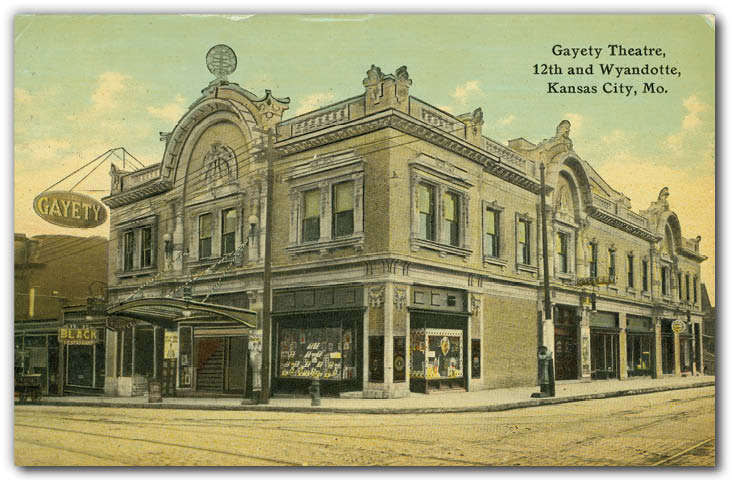By Michael Bushnell
Northeast News
July 29, 2015
Built of reinforced concrete and ornamental brick at a cost of $115,000, the Gayety Theater stood on the former site of the A.W. Armour home, one of the founding partners of world-famous Armour Meats.
The Gayety Theater was completed and opened to much fanfare in the spring of 1909. Designed by noted Kansas City architect Carl Boller, the “L” shaped property fronts both 12th and Wyandotte Streets, adjoining the Muehlbach Hotel in the rear of the theater along 12th Street. The new theater had a seating capacity of almost 1,600 — 570 of which are on the orchestra floor, 100 in boxes, 400 in balcony and 500 in gallery.
The main entrance of the theatre was through a lobby off of 12th Street and the gallery entrance was on the Wyandotte side. Sixteen offices were located on the second floor while storefronts occupied the first floor, with the exception of the two theater entrances.
A ghost, known as the “Blue Lady,” is said to haunt the Muehlbach Hotel. Some of those who are in the know think she is the spirit of an actress who once played the Gayety and now wanders the halls of the Muehlbach Hotel in search of a long lost lover. The theater was razed in 1950 to make way for an expansion of the Muehlbach, now part of the Marriott, formerly the Barney Allis Hotel. The card was sent to Mr. I. L. Smith, Riverview Place, Hastings on the Hudson, New York, on Oct 23, 1911. The message written on the back of the card says: “Dear Irving, This is the theatre where we are playing – very nice house but the dressing rooms are as small as cigar boxes. Will write a long letter some time this week. Kindest regards to all the boys. From Jack.”
The Boller Brothers firm was responsible for the initial design or remodeled designs of more than 100 theatres throughout 15 western states as their business skyrocketed to accommodate the growing legion of movie-goers in the post World War I United States. In 1920 the brothers established an office in Oklahoma City to oversee numerous theater projects throughout Oklahoma. In 1922, brother Carl opened a satellite office in burgeoning Los Angeles to supervise the growing number of projects in the Southwest. Theaters throughout the Midwest built after 1920 are generally assumed to be Boller Brothers designs. Disaster struck, however, in October 1929, when the Great Depression spread throughout the land and in 1931 the firm dissolved.
Movies and shows were considered luxuries for only the well- to-do and theater construction all but ground to a halt throughout the Depression years. Carl Boller died in California in 1946 and Robert died in 1962 in his home in Dallas. Examples of Boller-designed theaters can still be seen throughout Kansas City and yes, Historic Northeast. The Benton Theater at Independence Avenue & Benton Boulevard is of Boller design, as is the Aladdin Theater, located on Truman Road and Belmont. Others include The Granada (900 Minnesota Ave.), The Ashland (2400 Elmwood) and The Gillham (3100 Gillham Rd.) For more information on the forgotten architecture of old show palaces, check out www.cinematreasures.org.




















